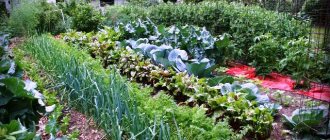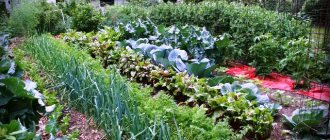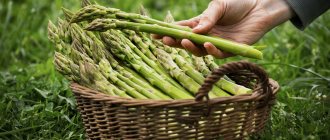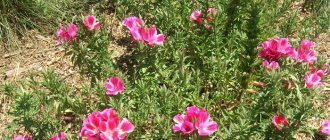“Where to start and what vegetables should I plant in my first garden?” – any first-year summer resident asks. We offer you ten garden crops, for the cultivation of which you do not need to comprehend any wisdom.
All vegetable crops are divided into root vegetables, nightshade, pumpkin, cabbage, green, etc. Summer residents divide them into only 2 groups - difficult to grow and simple. If a vegetable garden is the meaning of life for you, the joy without which the world loses its color, you can safely take on growing even the most capricious crops. If you only occasionally visit the dacha or are just trying your hand at this, nature has created simple vegetables for you. We will talk about them.
- The first bed of a novice gardener - tips for beginners
Where to start arranging a garden bed and what plants to choose? Find out from our material
Green and aromatic crops
Not all aromatic herbs are equally easy to grow. Among the simplest, and therefore ideal for a novice summer resident, dill and parsley come first. They are quite cold-resistant, so you can start sowing seeds in open ground as early as April. These herbs will grow best in a sunny location. They usually begin to pick young greens a month and a half after sowing.
It is no more difficult than dill and parsley to grow green crops such as sorrel and lettuce. They are absolutely unpretentious to growing conditions. Water them, remove weeds from time to time - and these crops will thank you with abundant greenery. Sowing can begin at the end of April. Lettuce seeds should not be sown all at the same time - do it every 2 weeks. In this case, you will have fresh greens with soft, tender leaves on the table throughout the summer.
- Early greens for sale - learning to grow
Greens grown for sale should be vibrant, healthy and inexpensive. You will be glad to know that this is possible and takes minimal time.
Vegetable amaranth
Combines decorative and gastronomic qualities. In terms of taste and vitamin content, it is superior to spinach, and in terms of medicinal effects it occupies one of the first places among vegetable crops. Vegetable amaranth not only treats some diseases, but also prevents them, and also improves metabolism. The crop is sown directly in open ground in the first ten days of May; it prefers open sunny places. Basic care consists of abundant watering and timely weeding. The leaves should be harvested in the first half of summer, before the plant blooms.
Fashionable and mysterious. Why amaranth is eaten by adherents of a healthy lifestyle and astronauts Read more
Radish
Growing radishes in open ground will also not cause you any particular difficulties. Just sow it at the end of April - and within a month you will be eating your own grown vegetable. Repeat sowing, as in the case of lettuce, every 7-10 days so that you always have young radishes.
Experienced gardeners, taking into account the short growing season of radishes, sometimes grow them between rows of crops with a long ripening period. While, for example, carrots or onions are ripe, you will have time to collect several harvests of radishes.
- Growing radishes: 8 secrets of a bumper harvest
The main principles of radish care that will provide you with a rich harvest of root crops.
Garden quinoa
The culture contains valuable proteins, mineral salts and carotene. The main use in cooking is soups and salads. The plant is characterized by early ripening; 20 days after emergence, begin harvesting.
Beautiful and useful. We grow garden quinoa on the plot Read more
Carrot
The root vegetable, rich in β-carotene, also does not require special skills when growing. You can sow carrots in open ground as soon as the top layer of soil warms up well and dries.
To get a good harvest, only a few conditions must be met. The most important two:
- Plant carrots in a bed that receives full sun all day because they are a very light-loving crop.
- Do not add fresh manure to the soil before planting, otherwise you will not be pleased with the taste or size of the root crops.
- Everything about growing carrots - detailed instructions for beginners
You can find a bed of carrots in most summer cottages. However, does everyone know how to grow it correctly?
Rhubarb
Suitable for decorating flower beds and various areas of the site: its leaves are luxurious, it blooms with tall candles. The crop is grown through seedlings and division of rhizomes. A perennial, cold-resistant and shade-loving plant that requires virtually no care. Young rhubarb petioles are used for food.
About the tops and petioles. How to grow rhubarb in the country More details
Beet
Even a novice gardener can grow a red root vegetable. In the middle zone, beets can be sown in open ground only after the threat of frost has passed, that is, not earlier than the end of May. Shoots appear very quickly (after 4-5 days) and they can withstand only slight short-term cold snaps (up to – 1-2°C). Early varieties of beets can be eaten after 3 months, late varieties are removed from the beds in October.
- Growing beets - revealing all the secrets
Growing beets in your garden is not a difficult task. But you can still accidentally destroy the crop without knowing these secrets.
We are planning landings
- Draw a plan of your site on graph paper, to scale. Format no smaller than A3. No need to sketch by hand on your knee, take accurate measurements. You will need a tape measure and an assistant.
- Mark on the site diagram all existing and planned buildings: house, barn, utility rooms, swings, gazebos, barbecue area or pool, all flower beds, compost heap. We separately note the vineyard (if there is one or planned).
- Make a copy of the site plan, for example, on tracing paper or redraw it, photocopy it, as there may be several options.
- In the entire space free from buildings and flower beds, select zones based on illumination: the sunniest places and the shady ones. To do this, take a day and look carefully at where the shadows of trees and buildings fall.
- Mark the water source.
- Choose places where you can put greenhouses or a greenhouse - these are the widest areas. Consider the distance between paths and rows. The passage for a wheelbarrow should be at least 50-60 cm; the larger the area, the greater the width of the paths you can afford. But if the plot is small, it all depends on your appetite: are you ready to make do with 30-centimeter passages between the beds or do you need more to turn around while weeding.
- If you have made a large list of planned plantings in the garden, it is better to make more narrow beds of 45-60 cm than wide meter beds.
Bulb onions
Almost no dish is complete without this vegetable. Even beginners can easily cope with growing onions in open ground. It is bred in several ways: seeds, using onion sets and seedlings. The easiest option is to plant onion sets in the garden in the spring. In this case, you can harvest already in July-August. The main thing is to correctly determine the optimal planting time: the soil must warm up well (otherwise the onion will shoot), but not dry out (otherwise the vegetable will develop slowly).
- Secrets of planting onions in the garden
Onions are grown as an annual, biennial and sometimes triennial crop. What is the difference?
What crops can be combined with each other in the garden?
Before planting crops, it is necessary to familiarize yourself with information regarding crop compatibility. Below is a list of the main crops and plants that can be combined and which are best planted at a distance from each other.
Cucumbers. This vegetable goes well with:
- salad,
- radish,
- sunflower,
- corn,
- tomatoes,
- peas.
Cucumbers have poor compatibility with:
- sage
- fennel,
- dill,
- mint.
Tomatoes. Adjacent to:
- garlic,
- carrots,
- spinach,
- onions,
- corn,
- cabbage,
- parsley
It is better not to plant next to tomatoes:
- potatoes,
- beets,
- fennel.
You can sow next to cabbage
- beets,
- potatoes,
- beans,
- mint,
- dill.
These vegetables do not go well with:
- tomatoes,
- strawberries.
Eggplants can be planted near any vegetables (for example, cauliflower), but the best neighbors are:
- legumes,
- aromatic herbs.
Potatoes prefer proximity to:
- cabbage,
- radish,
- corn,
- beans,
- salad.
You should not plant next to potatoes:
- tomatoes,
- pumpkin,
- cucumbers
Carrots go well with:
- onions,
- tomatoes,
- sage
- garlic,
- beans,
- radish.
But it is not advisable to combine dill with carrots.
The bow is compatible with:
- cabbage,
- carrots,
- beets,
- salad,
- radish,
- strawberries.
Bad neighbors are:
- beans,
- peas.
Combine pepper
- basil,
- coriander,
- carrots,
- onions
It is advisable to exclude from:
- fennel,
- beans.
Radishes react calmly to proximity to any vegetables.
Salad. Will be a good neighbor for:
- wild strawberries (strawberries),
- beets,
- peas,
- tomatoes,
- cabbage
Salad does not get along well with parsley, but it does well with chrysanthemums.
Beet. It has good compatibility with cabbage, but does not go well with tomatoes and beans.
Beans. Develops normally, adjacent to:
- cabbage,
- beets,
- tomatoes,
- pumpkin,
- carrots.
Doesn't go well with:
- leeks,
- garlic
Garlic , if possible, grows well next to gladioli.
Garlic
Garlic, another crop that is not difficult to grow, comes in two types: winter and spring. The time for planting spring garlic is mid-April - early May, when the soil warms up well enough. Winter garlic should be planted in the garden about a month before the onset of cold weather. After planting, be sure to mulch the bed, then your garlic will not be afraid of winter frosts. For any type of garlic, choose a bright, draft-free place with a low groundwater level, because garlic does not tolerate waterlogging.
- How, when and where to plant garlic in the spring
If you think that garlic is planted in garden beds only in the fall, you are mistaken. Meet spring spring garlic.
What to plant in a large area. Planning
Before planting an orchard, it is recommended to make at least a rough plan for planting trees. Having made sketches on paper, you can personally imagine how the site will look in general terms.
There are two types of planning: landscape and regular.
Adherents of geometric clarity and orderliness of forms will enjoy a garden in a regular style. In it, trees and berry bushes are planted in even rows at equal intervals. Garden beds are laid out in the shape of regular rectangles and squares, separated by smooth paths laid in straight lines. With this arrangement, you always know what is where, and it is easier to care for the plantings.
Approximate plan of a summer cottage with an area of 6 acres: 1 - house; 2 - garage; 3 - household yard; 4 - place to rest (gazebo); 5 - lawn, flower bed; 6 - front garden; 7 - planting strawberries; 8 - vegetable garden; 9 - garden
Landscape, or free planning, is close to the natural style. Plants are planted according to a pre-designed scheme, but are not arranged in a strict order, but in groups. Along with fruit trees and shrubs, ornamental vegetation is used, and vegetables can coexist with flowers. Creating a landscaped garden requires creativity.
The ratio of the garden area to the area of the plot is a relative concept and depends only on the owners of the land plot. No one has established standards for the balance of the territory, so an orchard can occupy more than half of the territory (if the owner wishes this), or it can be tiny and consist of only 3-4 trees.
Helpful advice. If there is not much land for a garden, but you want to plant more trees, additional “land resources” are found. You can plant 2-3 fruit trees in the front garden, located between the facade of a residential building and the fence. With a small front garden, it is permissible to use the space behind the fence, however, here you can plant not very valuable types of trees, the fruits of which there are not many hunters: mulberry, apricot, summer apple tree, Hungarian plum, simple cherry.
Zucchini
Did you know that not only the fruits of zucchini are eaten, but also its flowers? For example, stuffed zucchini flowers are quite popular in France. Would you like to try this delicacy? So, we need to grow it. It's not difficult at all. In the first days of summer, when the threat of frost has passed (zucchini is a heat-loving crop), plant seeds or seedlings in a bed protected from drafts and wait for the harvest. However, weeding, loosening, watering and a few fertilizing will not hurt - and that’s it, you are guaranteed a large harvest of zucchini.
Another representative of the Cucurbitaceae family has similar growing conditions – pumpkin. At the early stage of growing a vegetable, the danger for it is not only sub-zero temperatures, but also birds. Branches, hay, plastic bottles, netting, etc. will help protect against them. After the true leaves appear, the cover can be removed.
- Zucchini: planting, growing and care in open ground
We'll tell you how to plant zucchini and take care of them until harvest.
Fruit garden with exotics
This may seem incredible, but on 2.5 acres you can grow about 100 fruit trees and shrubs!
Gardeners always lack land: they want to plant more and more of everything, but the size of the plot does not allow it. Well, what can be placed on 6-10 acres? A couple of apple and pear trees, a few currant and gooseberry bushes, a small plantation of raspberries and strawberries, leave the land for a garden, and plant flowers somewhere. Meanwhile, new products appear on sale every year. Either interesting varieties of frost-resistant hazelnuts will catch your eye, or seedlings of the incredibly popular goji berry. Blueberries would also be nice to have in the garden. Where should I plant all this? Believe me, there is room even for exotic crops! The main thing is to plan the site correctly. We were puzzled by this question, made a plan, and it turned out that just a gigantic number of varieties and species fit on 2.5 acres!
Garden with exotics
Pay attention to the plan: we placed in the garden not only classic crops, but also quite rare ones: hazelnuts, walnuts, chokeberries, thorns. They even found a place for such a curiosity as the goji berry!
The main trick
In our case, all the plants are planted not in rows, but offset. By the way, you can use this method both in the flower garden and in the vegetable garden - this way many more plants fit in!
On the plan they are all located taking into account the height: on the north side the highest, on the south the lowest. This is how they will not obscure each other. We made exceptions only for 3 crops: rowan, chokeberry (chokeberry) and hawthorn. They are not placed quite according to the rules - in the shade. And their productivity will naturally be lower. But we took this “violation” deliberately, since there are not many such berries needed. Well, you see, it’s unlikely that anyone will need 10 buckets of hawthorn. Sloes sit behind apple trees deliberately - this is the only fruit crop that can grow in the shade.
3 components of success
A garden in which trees are planted quite densely requires special care.
First, they need to be trimmed correctly. They say that a sparrow can easily fly through the crown of a well-formed apple tree. We will say more: the crown can be made so that a goose can fly there! In this case, the harvest will be no less, but such a crown provides very little shade. And neighboring crops can be planted closer.
Secondly, a compacted garden needs to be watered more often, since the roots of trees and shrubs intertwine in the soil and take water from neighbors. So don't be lazy about giving them water. Thirdly, a compacted garden needs to be better fed. Not more often, but better! At the same time as the classic one, but the dose of fertilizer should be approximately 50% higher.
When choosing varieties, pay attention to the shape of the crown and choose compact options - rollicking plants will be inappropriate here. When you start forming them, keep in mind that you will have to walk around the garden, and there are no paths as such. Therefore, do not spare the lower branches - cut them out immediately.
Peas
If you have a piece of land, for example, near a chain-link fence or wooden fence, then the best option is to sow peas there. Peas are a vertical crop; they definitely need support, and a fence will save you from the need to specially install it.
Sowing peas can be started no earlier than the beginning of May, so that the soil has time to warm up well. Before planting, soak the seeds for a while in a wet cloth to improve germination and speed up the ripening of the fruit.
- What peas can be sown in August - the best varieties and proper agricultural technology
The middle and even the end of summer is the time to start the second wave of planting in the garden.
Zemklunika
Berry culture combines all the best qualities of both strawberries and wild strawberries. Its dark berries are much larger than strawberries and emit a strawberry aroma. The taste of zemklunik is the sweetest. The bushes are decorative - they are tall, look like bouquets and, accordingly, bloom in whole clusters of large white flowers. When you look at a blooming strawberry, you only see a cloud of white flowers; sometimes you can’t see the leaves at all. The berry crop is unpretentious, caring for it is the same as for strawberries, and even simpler: this plant does not form mustaches. The only difference is that it requires more water. Refers to garden exotics: rarely available for sale.
Berry No. 1. What do you get when you cross strawberries and strawberries? More details
Potato
The main problem when growing potatoes is the Colorado potato beetle. However, it can be successfully combated, especially in small beds, without even using chemicals. To do this, walk around your plantings every day and manually collect pests in any container filled with soap solution or kerosene. From time to time, throw out dead beetles from there.
Otherwise, growing potatoes is not an extremely difficult task. In addition to standard weeding, potato bushes need hilling. Thanks to this procedure, the formation of tubers is activated, which means the yield increases.
- Traditional and new methods of growing potatoes: pros and cons of each
There is no gardener who has never grown potatoes in his life. But people tend to strive for perfection in everything. Growing potatoes is no exception. Today, many summer residents know how to get maximum yield from a small plot!
borage
The decorative accent of the vegetable garden has beautiful blue flowers, but the leaves have the aroma of cucumber. Borage is useful from all points of view: it is a valuable honey plant, its greens are tasty and rich in vitamins, and in addition, it is also a medicinal plant that is used for diseases of the cardiovascular and nervous systems. The only requirement of the culture is fertile soil and a sufficient amount of water, but otherwise it is an extremely unpretentious, cold-resistant and shade-tolerant plant. Sow borage directly into the ground in early spring.
Multi-colored hot pepper
This pepper can be grown both in open ground or a greenhouse, and on a windowsill. And your favorite fresh seasoning will always be at hand. In addition, decorative hot pepper in the form of a green bush with bright fruits decorates the interior. The shape of the fruit, color, size and location on the plant may vary depending on the variety. Peppers come in red, orange, yellow, sometimes white and even purple. Typically, the color of the fruit changes as it ripens.
The fruits of some ornamental varieties may be inedible.
How to grow colorful peppers
You can sow hot peppers for growing indoors at any time of the year. But it’s still better to give preference to early spring.
To sow indoor peppers, you need small pots. Drainage is placed at the bottom. A rich and nutritious substrate based on leaf soil, peat and sand is well suited.
The seeds are buried 1 cm deep in the ground, the crops are covered with film on top and placed for germination at a temperature of 23-25°C. After the sprouts appear, the protective film is removed after 7-12 days. Seedlings are watered regularly and moderately.
Picking is carried out at the stage of two or three true leaves. Two to three hours before picking, the sprouts should be watered to avoid the soil falling off the roots.
In order not to waste time on picking in the future, you can immediately sow the seeds of decorative peppers in separate pots.
After the seedlings have finally grown stronger and grown to the stage of 6-12 leaves, they are transplanted into containers with a volume of 3-5 liters.
Water indoor peppers frequently and sparingly. During fruiting, the plant requires more moisture. Usually watered in the morning, at the root, with further careful loosening of the soil.
In spring and summer, plants can be planted in open ground.
- 6 steps to hot pepper
Do you like chili peppers? Then stop buying it from the market and start growing it yourself.
Varieties and hybrids of colorful peppers
The best varieties of multi-colored peppers:
- Queen of Spades (the plant is compact, in open ground reaches a height of 30 cm, the shape of the bush is oval. The fruits are spicy, tasty, aromatic, and turn purple when fully ripe).
- Aladdin (an ultra-early ripening variety, bears fruit abundantly and for a long time, height in open ground - 50 cm, in a room - no higher than 35-40 cm, fruits are small, numerous, elongated cone-shaped, sharp and aromatic. At the stage of technical ripeness, the pods turn from green to cream and purple, then turn red).
- Loko F1 (the plant forms a well-branched bush with a height of 35-45 cm to 60 cm. The period from germination to ripening is 82-90 days. The fruits are oval in shape, as they ripen they change their color from purple to bright red. The taste is gently pungent ).
- The best varieties of hot peppers for growing on the window
Hot peppers are one of those crops that do well in apartment conditions. What varieties of hot peppers are best for growing on a windowsill?
Application
Pepper fruits are used fresh and canned for preparing lecho, as a seasoning for seasoning soups, for preparing dishes with stewed meat, various national dishes, vegetable salads, and sauces. Peppers can be pickled, grilled and salted.
What trees are not advisable to plant near the house and why?
Some representatives of the flora are not recommended to be planted near the house. Some - due to natural reasons, others - due to superstition.
Giants with powerful roots should not be placed close to buildings. Over time, the root system can develop and go so deep that it disturbs the foundation of the building. These include poplar or walnut.
It is better not to plant pine trees on the site, or to distance them as much as possible. Their features are such that they can destroy all the vegetation around them.
Plants are believed to have a certain energy. Everyone's aura is special and can give or take away strength. According to superstitions, it is undesirable to plant the following flora representatives near the house.
Birch
In fact, birch is a real protector. However, it is better to take it outside the gate and build a bench next to it. There she will not disturb the owner and will not let negativity enter the doorstep.
Aspen
Our ancestors also considered aspen an energy vampire. According to legends, she brings illness and loss. The cross of Jesus Christ was made of aspen.
Willow
Some say that whoever plants it will soon suffer death. Even if you are not a superstitious person, you should not tempt fate.
Willow
It often grows near bodies of water, but is not suitable for planting near a house. The willow tree is traditionally considered a symbol of crying and suffering; in the old days, women came to it to grieve over their difficult fate.
Perennial flowers
This is a very convenient option for those who do not have time to replant flowers and change their composition every year. Rooted perennials will beautify the garden for many years. Among them, the most popular are dahlias and peonies. The latter are capable of blooming vigorously throughout almost the entire summer period. In addition to flowers, the dark green glossy leaves of this plant also serve a decorative function. They are planted in well-lit areas that are not subject to flooding or high humidity.
Dahlias begin to bloom towards the end of summer. They need fertile soil with good moisture. Like any other garden ornamental plant, dahlias require regular feeding, timely watering and weed control.











